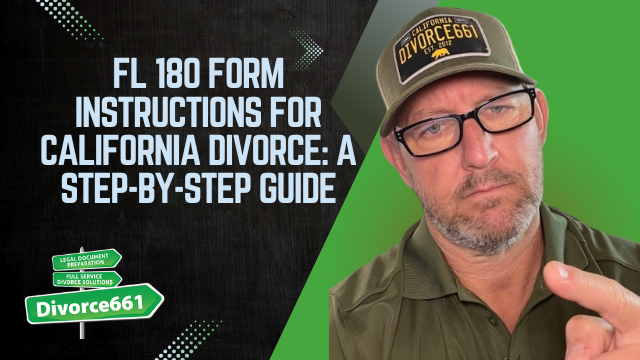FL 180 Form Instructions for California Divorce: A Step-by-Step Guide
Completing the FL 180 form is a crucial step in finalizing your California divorce. Whether you’re navigating this process on your own or looking for detailed guidance, understanding how to correctly fill out this form—and the related documents—is essential to avoid delays and confusion. In this guide, I’ll walk you through the ins and outs of the FL 180, share insights on preparing your judgment paperwork, and introduce you to resources that can simplify the entire divorce process.
Understanding the FL 180 and Its Role in Your Divorce
The FL 180 is a core document used in California divorce cases. It summarizes the judgment details, including child custody, support orders, property division, and other key decisions. This form is part of the final paperwork that officially concludes your divorce.
Many people get stuck at this phase, often referred to as “Step 3” in the divorce journey, because it involves not just the FL 180 but several additional forms depending on your unique circumstances. If you have children, property, or other assets, you’ll need to prepare extra documents alongside the FL 180 to ensure your judgment is comprehensive and court-ready.
Step-by-Step Guidance on Completing the FL 180 and Related Forms
Filling out the FL 180 form correctly requires attention to detail and an understanding of your divorce specifics. Here’s what you should keep in mind:
- Identify your case type: Different divorce cases—such as those with children, without children, or involving property—require different forms and considerations.
- Prepare all necessary documents: Besides the FL 180, you may need to complete financial disclosures, custody agreements, and property division forms.
- Serve the documents properly: Serving your forms according to California court rules is vital for your case to proceed smoothly.
- Understand child custody and support issues: If applicable, make sure to clearly outline custody arrangements and calculate child or spousal support accurately.
- Handle defaults and no-response cases: If your spouse does not respond or participate, there are specific procedures to follow to finalize your judgment.
How to Avoid Common Pitfalls and Save Time
One of the biggest frustrations in the divorce process is dealing with unnecessary paperwork or filing forms in the wrong order. For example, even if you don’t have property to divide, there are still certain forms you need to submit to satisfy the court’s requirements.
To help you avoid these common issues, I’ve developed a comprehensive Divorce Judgment Checklist. This printable PDF guides you through every form and step, tailored to your specific divorce situation. Whether you have children or assets, the checklist breaks down what you need and links to detailed instructional videos for each form.
Why Use a Checklist?
- Streamlines the process: Know exactly what forms to prepare and when to file them.
- Reduces mistakes: Avoid filing unnecessary documents and missing critical ones.
- Saves time and frustration: Clear instructions help you move quickly through the paperwork.
Accessing Expert Help for Your California Divorce
If you’re feeling overwhelmed by all the paperwork and legal jargon, you don’t have to go it alone. At California Divorce Tutor, I offer a membership course for just $97 that walks you through every form—from the initial filing to the final judgment.
This course includes:
- Detailed video tutorials on completing each form
- Step-by-step instructions for cases with or without children and property
- Guidance on serving documents and handling child custody and support questions
- Support for navigating defaults and other common issues
- Access to the Divorce Judgment Checklist and other helpful resources
Having worked with the court system, I know what judges expect and the best way to present your paperwork to avoid delays or confusion. The course is designed to save you time, reduce stress, and help you confidently complete your divorce judgment.
Final Thoughts
Completing the FL 180 and associated forms is a vital step in making your California divorce official. With the right guidance and tools, you can handle this process more easily and avoid common mistakes that cause frustration and delays.
Remember, every divorce case is unique, so it’s important to tailor your paperwork to your specific situation—whether that includes children, property, or other considerations. Utilize checklists, instructional videos, and expert advice to ensure your forms are accurate and complete.
If you want a reliable, step-by-step resource that covers all aspects of your California divorce paperwork, consider checking out the comprehensive course at California Divorce Tutor. For just $97, you’ll gain access to all the tools and knowledge you need to complete your divorce with confidence.

